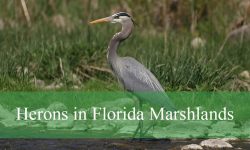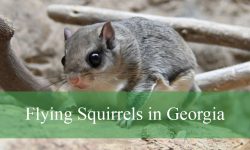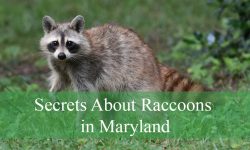Colorado has many different kinds of birds, and some of the most eye-catching are black and white birds. These birds have bold colors that make them easy to spot and interesting to watch. You can find them in forests, fields, near rivers, and many other places across the state.
Black and white birds in Colorado come in all sizes, from small songbirds to larger water birds. They play important roles in nature, like eating insects or spreading seeds. Learning to recognize them by their colors and sounds can make your time outside even more fun.
In this article, you will find 18 black and white birds that live in Colorado. Each bird is described with clear details and pictures to help you identify them. This guide is perfect for anyone who wants to know more about the birds around them.
Common Black and White Birds in Colorado
Black-billed Magpie (Pica hudsonia)

The Black-billed Magpie is a striking bird with glossy black-and-white plumage and long iridescent tail feathers that shimmer with blue and green in sunlight. Measuring about 17 to 24 inches in length, it has a black head, chest, and back, white belly and shoulders, and large wings with white markings. Its long tail can account for over half its total body length.
Magpies are intelligent, vocal, and highly social. They communicate using a variety of harsh calls, including “mag-mag-mag” and chatter sounds, and they are known for their complex social interactions. They forage on the ground and are opportunistic feeders, consuming insects, small animals, carrion, seeds, fruits, and even garbage. They often cache food for later use.
In Colorado, Black-billed Magpies are common year-round across open country, agricultural lands, and suburban areas, especially on the plains and lower foothills. They are easily observed perched on fence posts, power lines, or scavenging in open fields. Their adaptability and boldness make them one of the most visible black-and-white birds in the state.
Downy Woodpecker (Dryobates pubescens)

The Downy Woodpecker is the smallest woodpecker species in North America, with a body length of about 5.5 to 6.7 inches and a wingspan around 10 inches. It has a distinctive black-and-white plumage, with a white belly, black wings with white spots, and a bold white stripe down the back. Males have a small red patch on the back of the head, while females lack this feature. It’s often confused with the Hairy Woodpecker, though the Downy has a shorter bill relative to head size.
This species is active and acrobatic, frequently clinging to branches or tapping at tree bark in search of insects. Its call is a sharp “pik” and a descending whinny-like rattle, commonly heard in wooded areas. It drums on trees to establish territory and attract mates, though its drumming is lighter and less intense than that of larger woodpeckers.
In Colorado, the Downy Woodpecker is widespread and can be found year-round in forests, suburban parks, and backyards, especially those with mature trees. It feeds on insects, larvae, and spiders, but also enjoys suet, seeds, and berries at feeders. It is common across the state, from the foothills to the plains and even urban settings.
Hairy Woodpecker (Dryobates villosus)

The Hairy Woodpecker closely resembles the Downy but is larger, measuring 7.1 to 10.2 inches in length with a wingspan of about 13 to 16 inches. It shares the same black-and-white coloring, including the white back stripe and white undersides, but has a more robust appearance and a noticeably longer, chisel-like bill. Males also have a red patch on the back of the head, which females lack.
This species is more reserved and less noisy than the Downy, with a sharp “peek” call and a stronger, more deliberate drumming sound. It is known for foraging on tree trunks and limbs, often scaling bark to extract wood-boring insects. Hairy Woodpeckers are solitary for much of the year, becoming more social only during the breeding season.
In Colorado, Hairy Woodpeckers are residents in mature forests, particularly in the mountains and montane woodlands. They are more likely found at higher elevations compared to Downy Woodpeckers. Though they also visit feeders, they prefer areas with large trees and dense canopy for nesting and feeding.
Black-capped Chickadee (Poecile atricapillus)

The Black-capped Chickadee is a small, charming bird, measuring about 4.7 to 5.9 inches in length with a wingspan of 6.3 to 8.3 inches. It features a black cap and bib, white cheeks, soft gray back, and buffy flanks. Its body is rounded and compact, with a short bill and a constantly flicking tail. It is very active, flitting from branch to branch in search of food.
Its call is a clear “chick-a-dee-dee-dee,” which varies in intensity depending on threat levels. The song is a sweet, whistled “fee-bee” or “hey-sweetie.” Chickadees are curious and tame, often approaching humans, especially near feeders. They feed on insects, seeds, and suet, and they are known to store food in tree crevices for later use.
In Colorado, Black-capped Chickadees are found in riparian woodlands, deciduous forests, and residential areas throughout the foothills and along the Front Range. They are year-round residents and easily attracted to backyard feeders. Their cheerful presence and distinctive vocalizations make them a favorite among birdwatchers.
Mountain Chickadee (Poecile gambeli)

The Mountain Chickadee is very similar to the Black-capped Chickadee in size and shape, measuring 5.1 to 5.9 inches in length. It has a gray body, black cap and bib, white cheeks, and distinctive white eyebrow stripes that set it apart from its cousin. It also has more muted underparts and a more grayish overall appearance, suited for its high-altitude environment.
This species is vocal and social, with a hoarse “chick-a-dee” call and a rough “tschick-a-day” song. It is often found in small, active flocks, sometimes mixed with other small songbirds. Like other chickadees, Mountain Chickadees cache food and exhibit remarkable memory in retrieving it. They feed on insects, spiders, conifer seeds, and suet when available.
In Colorado, Mountain Chickadees are typically found in coniferous forests at higher elevations, especially in the Rockies and montane zones. They are year-round residents in these habitats, nesting in tree cavities and frequently visiting feeders in mountain towns and forested backyards. Their resilience and ability to survive harsh alpine winters make them a notable species of Colorado’s highlands.
White-breasted Nuthatch (Sitta carolinensis)
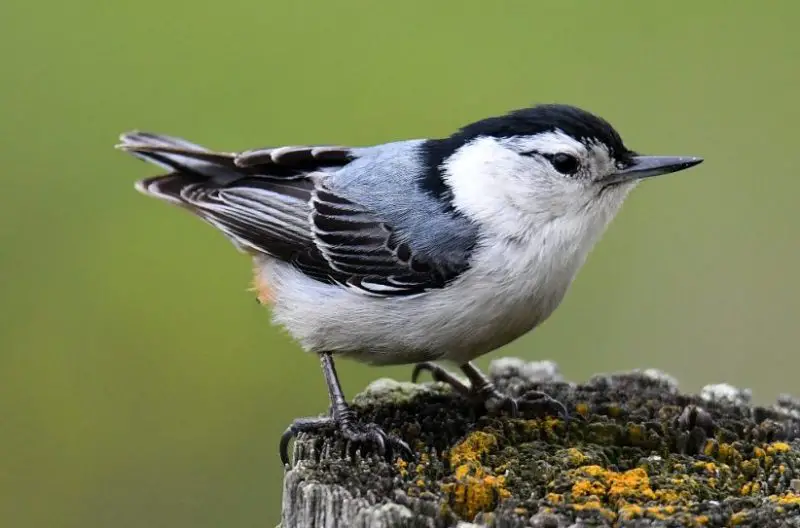
The White-breasted Nuthatch is a small, agile bird recognized by its striking black, white, and blue-gray plumage. It has a black cap, white face and underparts, and a short tail. Its compact body and long, slightly upturned bill are well-suited for foraging on tree trunks. This species is about 5.1 to 5.5 inches long with a wingspan around 8.7 to 10.6 inches.
Its vocalizations include a series of nasal “yank-yank” calls, and its song is a rapid, whiny repetition of notes. The White-breasted Nuthatch is often seen moving headfirst down tree trunks as it searches bark crevices for insects. It is highly acrobatic and forages individually or in small flocks, especially during winter when it joins mixed-species groups.
In Colorado, this nuthatch is found year-round in mature deciduous and mixed forests, especially in riparian woodlands and along the foothills. It is also a frequent visitor to backyard feeders offering sunflower seeds or suet. Its preference for tree cavities makes old woodlands or well-established urban parks prime habitat.
Snow Bunting (Plectrophenax nivalis)
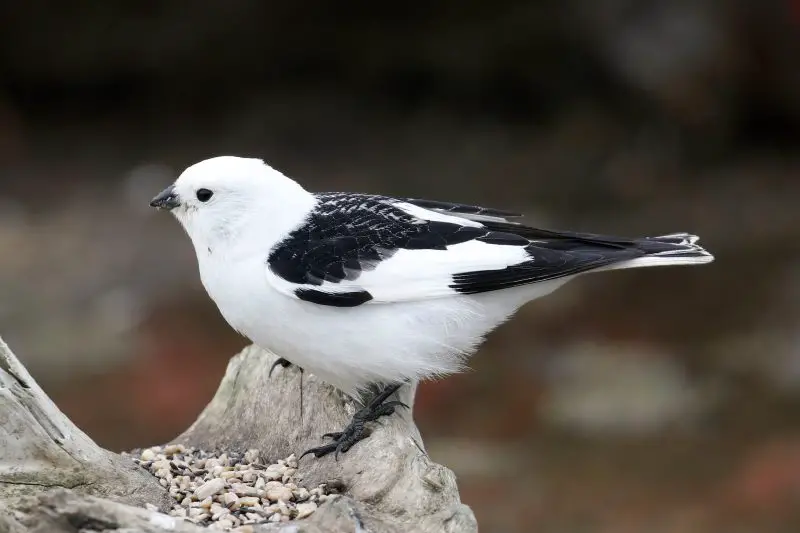
The Snow Bunting is a striking winter visitor to Colorado, known for its snowy white and black plumage. Males in breeding plumage are brilliant white with black on the back and wings, while females and non-breeding birds have more buff and brown tones mixed with the white. It is about 5.9 to 7.1 inches in length, with a wingspan of approximately 11.8 inches.
This bird is mostly silent outside of breeding grounds but occasionally gives soft twittering calls and rattling notes. Snow Buntings are ground-dwelling birds, often forming large flocks that forage for seeds on snow-covered fields or windswept grasslands. Their flight is strong and bounding, often low to the ground in tight formations.
In Colorado, Snow Buntings are uncommon but regular winter visitors, particularly in the eastern plains and high-altitude open areas. They migrate south from the Arctic tundra during the colder months and are usually spotted in dry crop fields, grasslands, or flat, open terrain where snow cover is light. Their presence signals the harshness of winter and the resilience of Arctic-adapted species.
Common Loon (Gavia immer)
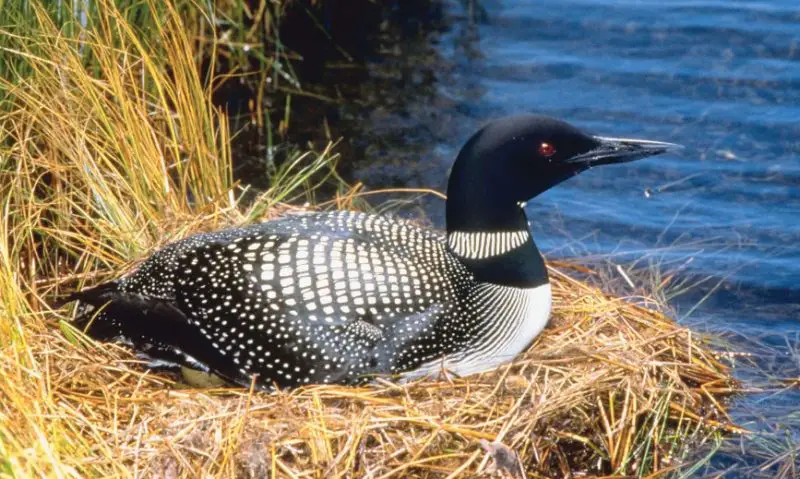
The Common Loon is a large, elegant waterbird with a distinctive black-and-white checkered back, black head, red eyes, and white underparts during breeding season. In winter, it becomes plainer gray above and white below. It is a hefty diver, about 26 to 36 inches long, with a wingspan ranging from 50 to 56 inches.
Its eerie, yodeling calls and tremolo cries are iconic of northern lakes during summer but are rarely heard in Colorado, as loons here are usually non-breeding migrants. Common Loons are expert divers, using their powerful legs to chase fish underwater. They are solitary when feeding but may gather in loose flocks during migration.
In Colorado, Common Loons are primarily seen during spring and fall migration on large lakes and reservoirs, particularly in mountain and foothill regions. Occasionally, they overwinter on ice-free waters. Notable locations include Eleven Mile Reservoir, Cherry Creek Reservoir, and lakes along the Front Range. They feed on fish, crustaceans, and aquatic insects.
Black-and-White Warbler (Mniotilta varia)
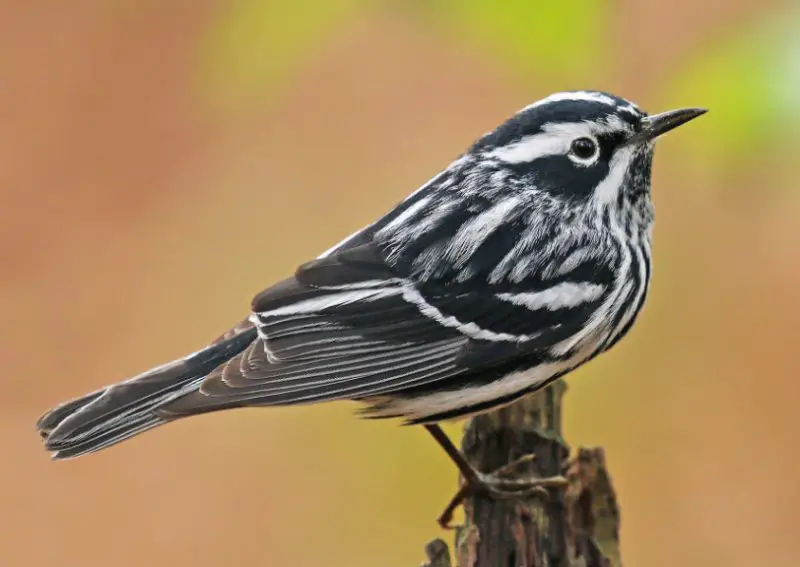
The Black-and-White Warbler is a unique songbird with zebra-like black and white stripes running lengthwise across its body. It has a thin, slightly curved bill, white underparts with black streaks, and black-and-white wings. Measuring about 4.3 to 5.1 inches in length with a wingspan of 7.5 to 8.7 inches, it is small but active.
This warbler has a high-pitched, squeaky song that sounds like “wee-see, wee-see, wee-see,” repeated in quick succession. Its call is a thin “tsip.” Uniquely among warblers, it forages like a nuthatch — creeping along tree trunks and large branches to probe bark for insects. It is agile and deliberate, sometimes appearing nearly upside down while feeding.
In Colorado, the Black-and-White Warbler is an uncommon migrant in spring and fall, typically observed in woodlands, parks, or riparian corridors. It favors mature trees and shaded areas during migration. While not a breeder in the state, its striking pattern and unusual foraging behavior make it a favorite sighting among birders.
Northern Mockingbird (Mimus polyglottos)
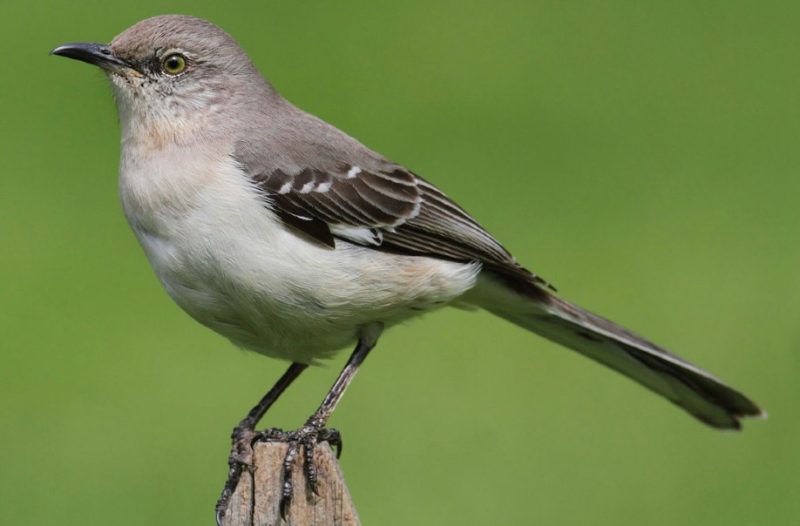
The Northern Mockingbird is a sleek, medium-sized songbird with gray upperparts, white underparts, and distinct white wing patches and outer tail feathers visible in flight. It measures 8.3 to 10.2 inches in length, with a wingspan of 12 to 15 inches. It has a long tail and slender bill, contributing to its elegant appearance.
This bird is famous for its vocal mimicry. Males sing long sequences that include imitations of other birds, mechanical sounds, and even frogs. Songs can go on for hours, especially during breeding season, and mockingbirds often sing both day and night. Their calls also include sharp “chak” and harsh scolding notes when disturbed.
In Colorado, Northern Mockingbirds are primarily found in the eastern plains and southern valleys, with smaller populations in urban areas and foothills. They prefer open habitats with shrubs and scattered trees, such as suburban neighborhoods, farmland edges, and desert scrub. Their diet includes insects in summer and berries in winter, and they fiercely defend their nesting territories.
Ladder-backed Woodpecker (Dryobates scalaris)
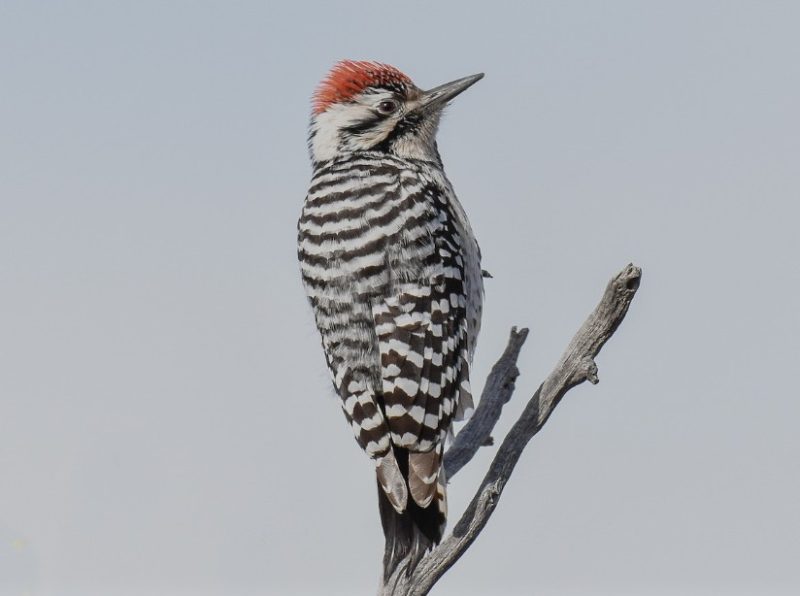
The Ladder-backed Woodpecker is a small, desert-adapted species recognized by the black-and-white barring on its back, which resembles the rungs of a ladder. It has a pale, lightly streaked underside, black wings with white spots, and a black-and-white facial pattern. Males have a red crown patch, while females have a plain black crown. Its size ranges from 6.3 to 7.1 inches in length, with a wingspan of about 13 inches.
This woodpecker is more quiet and elusive than its cousins, often giving a soft “peek” call and a brief, low drumming sound. It forages by climbing and pecking into small branches and trunks of desert trees and shrubs. It primarily eats insects, especially beetle larvae and ants, though it may also consume cactus fruits and seeds.
In Colorado, Ladder-backed Woodpeckers are found mostly in the far southeastern corner of the state, especially in areas like Baca County. They inhabit dry desert scrub, piñon-juniper woodlands, and cottonwood stands along arid streams. Their presence in Colorado is limited and localized, making them a prized sighting for birders exploring the state’s driest habitats.
Eastern Kingbird (Tyrannus tyrannus)

The Eastern Kingbird is a boldly marked flycatcher with dark slate-black upperparts and contrasting white underparts. It has a squared-off head, white-tipped tail, and a hidden red crown patch that is only visible during aggressive displays. This species is about 7.5 to 9.1 inches long, with a wingspan of 13 to 15 inches.
It is highly vocal, emitting sharp “kit-kit-kit” or chattering calls while perched or in flight. True to its name, the Eastern Kingbird is territorial and fearless, often attacking much larger birds that approach its nest, including hawks and crows. It feeds primarily on flying insects, which it catches in mid-air with impressive agility, often returning to the same perch.
In Colorado, Eastern Kingbirds are summer residents across the plains, foothills, and riparian zones. They are commonly seen perched on fences, utility wires, or shrubs in open country and farmlands. During late summer, they begin eating fruits in preparation for their long migration to South America. Their upright posture and contrasting plumage make them easy to identify in the field.
Black-necked Stilt (Himantopus mexicanus)

The Black-necked Stilt is an elegant wader with striking black-and-white plumage and exceptionally long, thin pink legs. It has a white underside, black back and wings, a long black bill, and a black cap that extends down the back of the neck. It stands 13 to 15 inches tall, with a wingspan of about 28 inches, making it one of the most graceful shorebirds.
Its call is a high-pitched, barking “kip-kip-kip,” often repeated loudly when alarmed or defending territory. Stilts forage in shallow wetlands and flooded fields by picking insects, crustaceans, and small aquatic animals from the water’s surface. They are known for their elegant posture and quick, deliberate movements across mudflats or marshes.
In Colorado, Black-necked Stilts are summer breeders primarily in the San Luis Valley, southeastern plains, and areas around the Arkansas River. They inhabit shallow ponds, reservoirs, and saline wetlands with open shorelines. Though not widespread, they are locally common where wetland habitat is available. Their appearance and behavior make them a favorite among photographers and birders.
Common Goldeneye (Bucephala clangula)
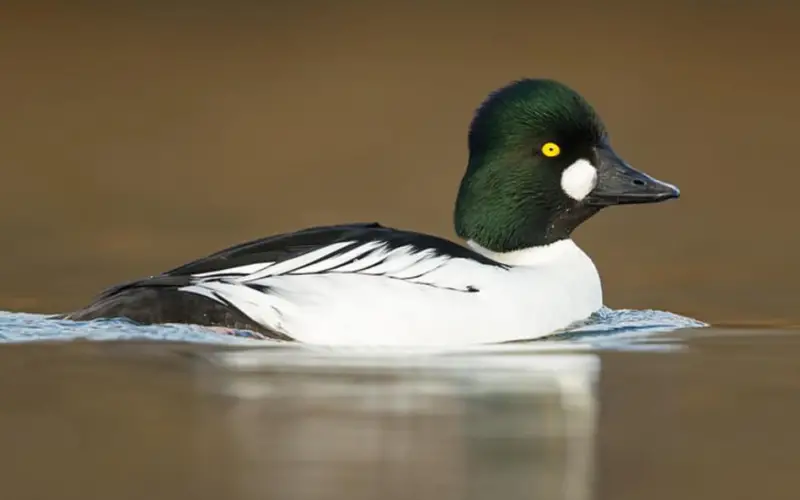
The Common Goldeneye is a medium-sized diving duck known for its black-and-white plumage and bright yellow eyes. Males in breeding plumage have a glossy green-black head with a round white cheek patch, black back, and white sides. Females are gray-bodied with a chocolate-brown head and yellow-tipped black bill. They are 15.8 to 20 inches long, with a wingspan of 30 to 32 inches.
Their vocalizations are usually limited to harsh grunts and soft whistles, especially in flight, but their wings produce a distinctive whistling sound when flying. Common Goldeneyes dive frequently to forage underwater for aquatic insects, mollusks, and crustaceans. They also eat plant material and fish eggs in certain seasons.
In Colorado, Common Goldeneyes are winter residents found on lakes, reservoirs, and rivers, particularly in the foothills and open mountain valleys. Some may stay into late spring or arrive early in fall. During migration, they are commonly seen in flocks, often diving and resurfacing together in synchronized motion. Their bright eyes and bold coloration help distinguish them from other diving ducks.
White-crowned Sparrow (Zonotrichia leucophrys)
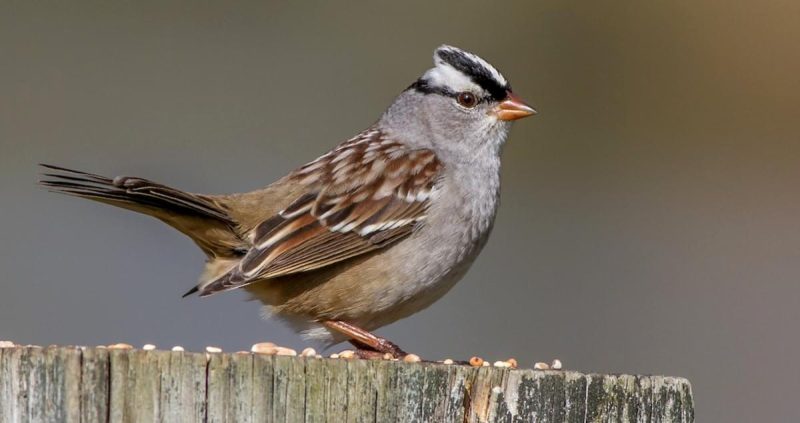
The White-crowned Sparrow is a medium-sized sparrow with bold black-and-white stripes on its head, a gray face and breast, and brown-streaked wings and back. Its bill can range from pinkish to yellow-orange depending on age and region. Adults measure about 6.3 to 7.1 inches long, with a wingspan of around 8.3 to 9.4 inches. Immature birds have brown and tan head stripes instead of black and white.
Its song is a sweet, whistled series of notes, often described as “Oh-dear-me” or “see-me, see-me,” with regional variations. The call is a sharp “pink” or “tsip.” These sparrows forage on the ground or low in shrubs, scratching for seeds, insects, and berries. They are known for their calm demeanor and are often seen in loose flocks during migration or winter.
In Colorado, White-crowned Sparrows are common during spring and fall migration and winter in the plains, foothills, and urban areas. They prefer brushy habitats, open woodlands, weedy fields, and backyard hedges. In summer, they breed in alpine and subalpine meadows, especially at higher elevations in the Rockies. Their head stripes make them one of the easiest sparrows to recognize.
Black Phoebe (Sayornis nigricans)
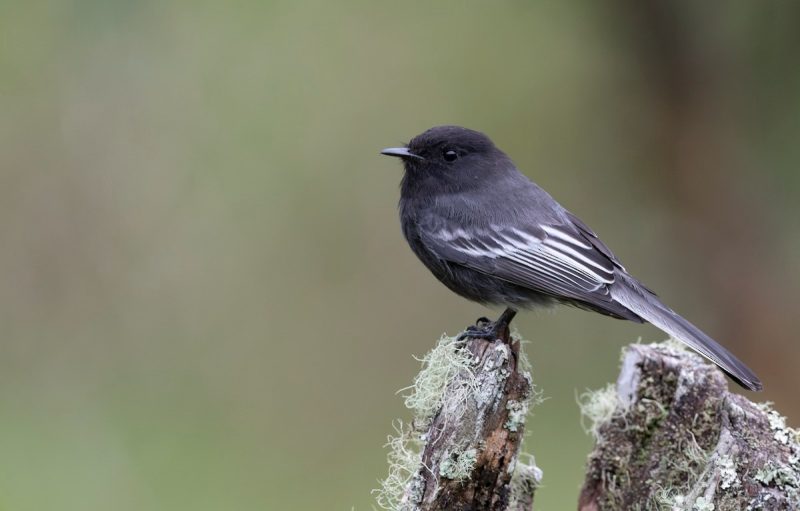
The Black Phoebe is a small, flycatcher species with sooty black upperparts, a black head and chest, and a sharply contrasting white belly. It has a thin black bill and dark tail that it often wags up and down. This bird is about 6.3 inches in length, with a wingspan close to 10.6 inches, giving it a compact, energetic appearance.
Its song consists of repeated phrases like “tee-hee, tee-ho,” and its call is a sharp, dry “chip.” Black Phoebes often perch on low branches, fences, or rocks near water, sallying out in quick flights to snatch insects from the air. Their wagging tails and confident perching habits make them easy to spot around streams and ponds.
In Colorado, Black Phoebes are mostly found in the southern and western parts of the state, especially near water bodies like streams, reservoirs, and irrigation canals. They are more common in warmer months but can overwinter in milder regions. They build mud-and-plant nests under bridges, culverts, or overhangs near water, showing a strong association with riparian environments.
Lark Bunting (Calamospiza melanocorys)
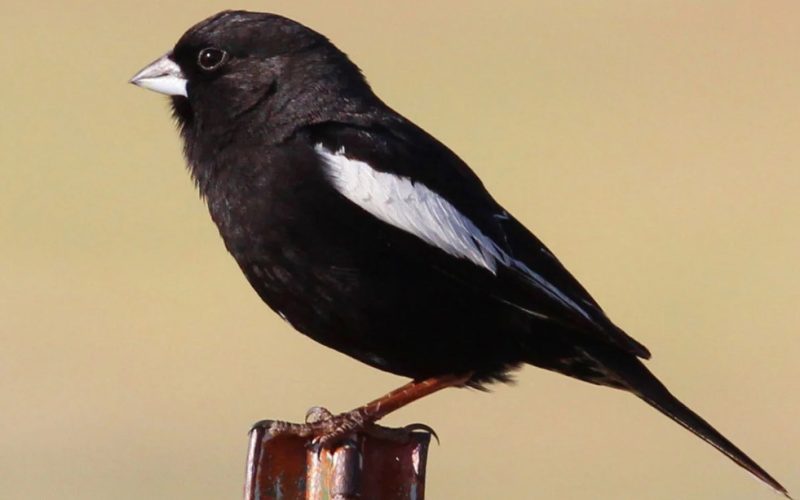
The Lark Bunting is Colorado’s state bird, known for the male’s striking breeding plumage: a jet-black body with a large white patch on each wing. Females and non-breeding males are streaked brown and white, resembling large sparrows. This bird is about 5.5 to 7.1 inches long, with a wingspan of 9.8 to 11 inches. It has a thick, conical bill suited for seed eating.
Its song is a sweet, melodic warble, often delivered in flight as the male flutters over the prairie. Calls include a soft “tseep” or “chew.” During breeding season, males perform flight displays to defend territory and attract females. Outside of nesting, they gather in flocks and feed primarily on seeds, though they also eat insects, especially for feeding young.
Lark Buntings are found throughout Colorado’s eastern plains during the summer breeding season, preferring shortgrass prairies, sagebrush flats, and open rangeland. After nesting, they migrate southward in large groups to winter in the southern U.S. and Mexico. Their bold appearance and graceful display flights make them a symbol of the state’s grassland heritage.
Loggerhead Shrike (Lanius ludovicianus)

The Loggerhead Shrike is a robin-sized songbird with a light gray body, black wings with a white patch, black tail, and a distinctive black “mask” across the eyes. It has a strong, hooked bill similar to that of a raptor, which it uses to impale prey. Adults are about 8.3 to 9.1 inches long, with a wingspan of 11 to 12.6 inches.
Its calls are a series of raspy buzzes and harsh “shack-shack” sounds, and it occasionally mimics other bird species. Despite its songbird classification, the Loggerhead Shrike behaves like a small predator, hunting insects, small birds, rodents, and lizards. It impales prey on thorns or barbed wire fences, using them as larders or to tear food apart due to its lack of strong talons.
In Colorado, Loggerhead Shrikes are summer breeders on the plains and in dry grasslands, sagebrush habitats, and pastures with scattered shrubs or fence lines. They are often seen perched on posts or wires scanning the ground for movement. While not as common as they once were, they remain a fascinating and unique part of Colorado’s prairie birdlife.

